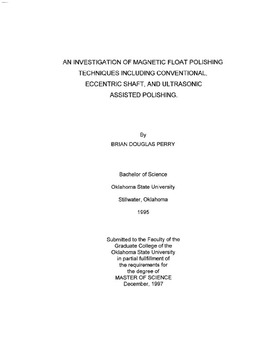| dc.description.abstract | Ceramic materials offer material properties that make them ideal candidates for use in ball bearing applications. These material properties include high compression strength, very high hardness, high wear resistance, and high temperature capabilities. By incorporating ceramic balls with steel races to create a hybrid ball bearing, a superior product is created that is capable of higher rpm's, higher temperature capabilities, lower lubrication requirements, and longer service life. Unfortunately, the same properties that make ceramics ideal for bearing use, also make them very difficult to manufacture to the high tolerances required for bearing use. The current industry practice is to use a V-groove lapping process with diamond slurry. This process uses very high forces, low rotation speeds, and very long polishing times. The high forces and hard diamond abrasives combine to create a lot of surface damage to the ceramic elements, that require long periods of time with small abrasives to repair. Magnetic Float Polishing (MFP) is a technique that has been developed that processes ceramic balls with little or no surface damage. This MFP process, which incorporates the use of magnetic fluid levitation, uses higher rpm's lower loads, and softer abrasives. The result is a ball that is finished in a fraction of the time needed with V-groove lapping. One drawback is that, currently, the results of the MFP process cannot quite match the results of the V-groove lapping, with respect to sphericity. The MFP process came about as a result of the evolution of many different techniques incorporating magnetic fluid in a machining process. The investigation documented here follows this spirit of evaluation and experimentation in order to improve upon the current state of the art. Three different aspects of MFP are considered in this investigation. First is the conventional method of MFP adapted to a new size of balls not previously considered. In the design of the new chamber, material choice and construction techniques are chosen in order to increase the dimensional accuracy of the chamber. This attention to dimensional tolerances is implemented in the hopes that it will improve the sphericity results of the balls. The second aspect of this investigation looks into the use of an eccentric, or offset, polishing shaft. The use of an eccentric shaft has been reported to achieve better sphericity results and higher MRR's. An eccentric shaft chamber is built and tested in order to evaluate the effectiveness of the eccentric shaft in producing better finished products. The third aspect covered here is the combination, or superposition, of the MFP process with the ultrasonic machining process. Ultrasonic machining is a process that is similar to the MFP process, in that, they both re ly on an abrasive slurry to remove material. It is hoped that by combining the two technologies, a superior final product can be achieved. Choice of transducer and placement of the transducer are two topics that must be considered when combining these two processes. In addition, a power supply must be chosen and incorporated to route the ultrasonic signal' to the transducer. These three topics are examined and evaluated in this investigation. Items used to evaluate the effectiveness of a given process are the sphericity and the surface finish of the balls produced, and the MRR achieved during the process. Improved sphericity and surface finish will result in a higher bearing quality (lower ANSI grade number). Increased MRR will help to reduce the time required to process the balls from start to finish, which will ultimately result in a lower cost. | |
